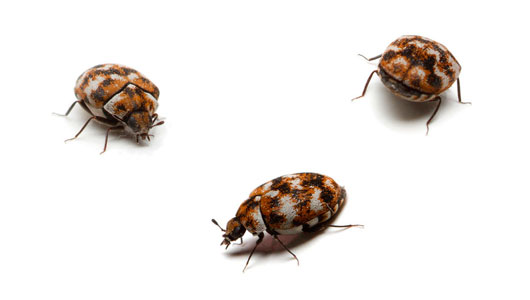Pest Control - Carpet Beetles
Pest Control Specialists have plenty of experience in Carpet Beetle extermination and control methods in Napier, Hastings, Taradale and throughout the Hawkes Bay and Manawatu. If you need help or advice just give us a call on 0800 737 872

Carpet Beetles in New Zealand
Carpet beetles, which belong to the family of beetles known as dermestids, are pests often found in warehouses, homes, museums, and other locations where suitable food exists. In New Zealand, three species of carpet beetles cause serious damage to fabrics, carpets, furs, stored food, and preserved specimens—the varied carpet beetle, the furniture carpet beetle, and the black carpet beetle.
Identification and life cycle of the Carpet Beetle
All three carpet beetle species have similar life cycles. Adults lay eggs on a larval food source such as woolen fabric, carpets or furs. Eggs hatch in about two weeks, and the larvae feed for varying periods, depending upon the species and environmental conditions. They prefer dark, secluded places. When ready to pupate, the larvae might burrow further into the food or wander and burrow elsewhere. They might also pupate within their last larval skin if no other shelter is available. Although larvae don't make webs as clothes moths do, their shed skins and fecal pellets, which are about the size of a grain of salt, make it obvious where they have been feeding.
Carpet beetle adults don't feed on fabrics but seek out pollen and nectar. They are attracted to sunlight, and you'll often find them feeding on the flowers of crape myrtle, spiraea, buckwheat, and other plants that produce abundant pollen. However, you can accidentally bring these pests inside on items such as cut flowers. With their rounded bodies and short antennae, carpet beetles somewhat resemble lady beetles in shape.
Damage caused by Carpet Beetles
Damage occurs during the larval stage of carpet beetles. Larvae feed in dark, undisturbed locations on a variety of dead animals and animal products such as wool, silk, leather, fur, hair brushes with natural bristles, pet hair, and feathers. Sometimes they feed on items such as certain spices and grains. They won't feed on synthetic fibres.
It's not always possible to tell from the damage whether clothes moths or carpet beetles are the culprits but in general carpet beetles are more likely to damage a large area on one portion of a garment or carpet while moth damage is more likely to occur as scattered holes. Also, carpet beetle larvae leave brown, shelllike, bristly-looking cast skins when they molt. These skins and a lack of webbing are usually good clues that carpet beetles are the culprits.
Controlling and exterminating Carpet Beetles
Carpet beetles are among the most difficult indoor pests to control because of their ability to find food in obscure places and to disperse widely throughout a building. Successful control depends on a combination of sanitation and exclusion. If exclusion and sanitation are successful, insecticide treatments will not be required.
Dermestids frequently fly into homes from flowers in the landscape. A few adult beetles in the house shouldn't be cause for alarm. A management programme needs to be implemented only if you find larvae developing in fabrics in your home. When carpet beetles threaten products in commercial warehouses or storage areas, a monitoring program using sticky traps baited with an appropriate pheromone (a chemical attractant an organism produces to attract others of the same species) is recommended. Sticky traps can also be used in homes where infestations are serious. Traps placed throughout a building can show where beetles are coming from. The traps are also useful for monitoring the effectiveness of control practices. Check traps once or twice a week. You can also use pheromone traps to work along side other control methods if you use them to attract adult males in small confined areas. Sticky traps are also available without a pheromone; you can place these traps on windowsills to trap adults that fly to windows.
For assistance with contolling Carpet Beetle and other pests in the Hawkes Bay and Manawatu Regions, please give us a call on 0800 737 872.
"A management programme needs to be implemented only if you find larvae developing in fabrics in your home."
Did You Know?
Adults lay eggs on a larval food source such as woolen fabric, carpets or furs.
Did You Know?
Dermestids frequently fly into homes from flowers outside.
A few adult beetles in the house shouldn't be cause for alarm.